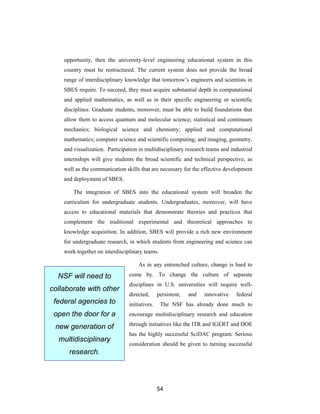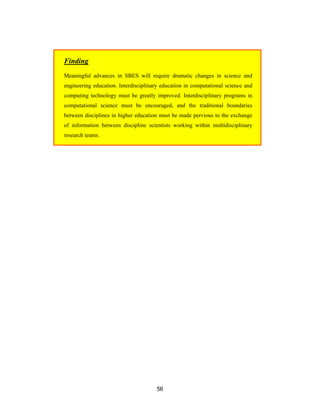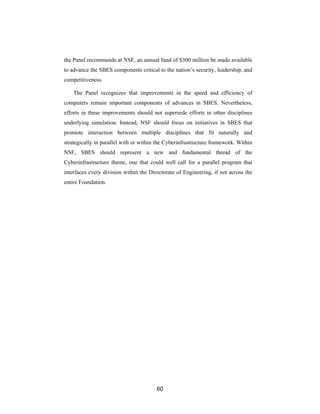This document is the final report of the National Science Foundation's Blue Ribbon Panel on Simulation-Based Engineering Science (SBES). The report finds that SBES has become an indispensable tool for solving scientific and technological problems and recommends ways to advance SBES through academia, industry, national laboratories, and government agencies. Key challenges discussed include multiscale modeling, verification and validation, big data and visualization techniques, and education initiatives to prepare engineers and scientists for the knowledge explosion enabled by SBES. The report highlights promising applications of SBES in medicine, homeland security, energy/environment, materials, and industrial/defense fields.
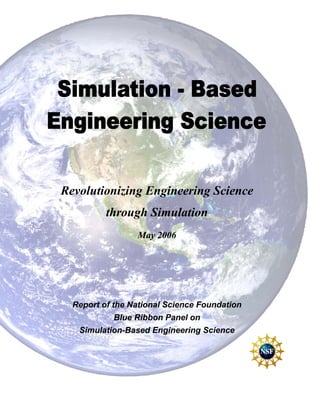













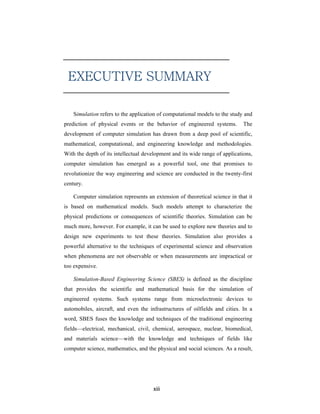






![This much is certain: there is overwhelming concurrence that simulation is
key to achieving progress in engineering and science in the foreseeable future.
Indeed, seldom have so many independent
Seldom have so many studies by experts from diverse perspectives
been in such agreement: computer simulation
independent studies been
has and will continue to have an enormous
in such agreement: impact on all areas of engineering, scientific
simulation is a key discovery, and endeavors to solve major
societal problems. This message is woven into
element for achieving
the principal findings of many key
progress in engineering
investigations. For example, the PITAC report
and science. [4] emphasizes the need to develop
computational science for national
competitiveness, and the SciDAC [26] and SCaLeS [18, 19] reports identify
opportunities for scientific discovery at the high end of today’s simulation
capabilities and call for a new scientific culture of interdisciplinary teamwork to
realize those capabilities. In addition, the Roadmap for the Revitalization of
High-End Computing [24] and the Federal Plan for High-End Computing [13]
both call for innovations in computer architecture to accommodate advanced
simulation. The Future of Supercomputing report [12] examines the role of the
Federal Government in sustaining the leading edge of supercomputing, and the
Cyberinfrastructure report [1] outlines a diverse program of interrelated research
imperatives stretching well beyond simulation into communication and data
technologies. Beginning with the Lax report of 1982 [20] and continuing with a
number of reports already appearing in this young century [3, 8, 9, 23], the
studies share a similar vision regarding the importance of simulation.
Consequently, the present report enters an arena already filled with voices
calling for more vigorous research and training in computation-based simulation.
The ideas in this report are in harmony with those voices, and in fact the report is
as brief as it is because others have already eloquently articulated the case for
2](https://image.slidesharecdn.com/sbesfinalreport-110314050635-phpapp02/85/Simulation-Based-Engineering-Science-Report-22-320.jpg)


![importance in broad areas of engineering analysis and design are well known. It
has become essential to product manufacturing. Its achievements in biomedical
applications are widely discussed. Systems design in defense, communication,
and transportation also rely on computer simulation.
At the heart of these successes, however, are simulation methodologies that
are decades old, too old to meet the challenges of new technology. In many ways,
the past successes of computer simulation may be its worst enemies, because the
knowledge base, methods, and practices that enabled its achievements now
threaten to stifle its prospects for the future.
Our nation prides itself in being the leader in computational science and
simulation theory and technology. Unfortunately, many indicators suggest that
the United States is quickly losing ground. Particularly in SBES, the country is
no longer positioned to lead the world over the next few decades. Even today, the
consequences of falling behind are penetrating deep into our technology and
economy, as well as jeopardizing our position in the
global community.
The importance and
Our global competitors are well aware of the great
potential of computer simulation. Throughout Europe great potential of
and Asia, governments are making major investments simulation have not
in computing, mathematical and computational
gone unnoticed by
modeling, algorithms, networking, and generally in
computational engineering and science. Indeed, these
our competitors
nations are building on the technologies that the U.S. around the world.
pioneered in the twentieth century. We are in danger,
once again, of producing world-leading science but leaving it to our competitors
to harvest the technological and economic advantages.
Yet, even our traditional lead in basic research is under threat. According to
[4, p. 9]: “Since 1988, Western Europe has produced more science and
engineering journal articles than the United States and the total growth in
5](https://image.slidesharecdn.com/sbesfinalreport-110314050635-phpapp02/85/Simulation-Based-Engineering-Science-Report-25-320.jpg)
![research papers is highest in East Asia (492 percent), followed by Japan (67
percent), and Europe (59 percent), compared with 13 percent for the United
States. Worldwide, the share of U.S. citations in scientific papers is shrinking,
from 38 percent in 1988 to 31 percent in 2001.” In Germany, 36 percent of
undergraduates receive degrees in science and engineering; in China, 59 percent,
and in Japan, 66 percent. In contrast; only 32 percent of undergraduates receive
such degrees in the United States [6, 25, 21].
The imbalance is beginning to reveal itself in international trade. “From 1980
to 2001, the U.S. share of global high-technology exports dropped from 31
percent to 18 percent, while the share for Asian countries rose from 7 to 25
percent” [4, p. 8]. Since 2001, the U.S. trade balance in high-tech products has
been negative.
The chief global economic competitor of the United States is China. In 2004
China graduated approximately 498,000 bachelor’s level engineers. By
comparison, India graduated 350,000 engineers, and the U.S. graduated 70,000
[6, 25]. The employment of an engineer in China costs roughly one-tenth to one-
sixth of what it costs in the United States. Some argue, however, that the U.S.
production of engineers, computer scientists, and information technology
specialists remains competitive in global markets when like-to-like data from the
representative countries are compared [11]. Nevertheless, even our competitors
in SBES believe that SBES research expenditures in Europe and Asia are rapidly
expanding while they are stagnant or declining in the U.S.
The key to offsetting those disadvantages is leadership in simulation. The
U.S. must be in the forefront of efforts to make simulation easier and more
reliable. We must extend the capabilities of simulation to the analysis of more
complex systems and the real-time acquisition of real-time data. Simulation must
no longer be relegated to the peripheries of an engineering student’s skill set;
instead, it should be a core part of the engineering curriculum, where it plays a
role in effective pedagogy.
6](https://image.slidesharecdn.com/sbesfinalreport-110314050635-phpapp02/85/Simulation-Based-Engineering-Science-Report-26-320.jpg)




![anatomic and physiologic data—to predict the outcomes of procedures and
thereby design optimal treatments for individual patients. This ability to predict
treatment outcomes and design procedures accordingly represents an exciting
new possibility for medicine.
Not only could physicians devise better treatments for individual patients, but
also manufacturers could use SBES methods to predict the performance of their
medical devices in virtual patients. The physical and animal testing procedures
currently used prior to human trials have significant limitations in their ability to
represent variations in human anatomy and physiology. With SBES methods,
manufacturers could conduct virtual prototyping of medical devices by
simulating the performances of alternate device designs for a range of virtual
Figure 2: The modeling of biomedical systems is becoming increasingly
sophisticated. Here is an example of a three-dimensional, tetrahedral-mesh,
heart model [27] developed from surface data obtained from the New York
University School of Medicine [22]. (a) Exterior view. (b) Boundary detection
represented in wire frame. (c) Cross-sectional view of the mesh. Patient-
specific modeling technologies need to be advanced significantly to make the
vision of Simulation-Based Medicine a reality. The benefits, however, are
impressive: dynamic models of deformation, blood flow, and fine-scale
capillary effects may greatly advance cardiovascular medicine.
11](https://image.slidesharecdn.com/sbesfinalreport-110314050635-phpapp02/85/Simulation-Based-Engineering-Science-Report-31-320.jpg)






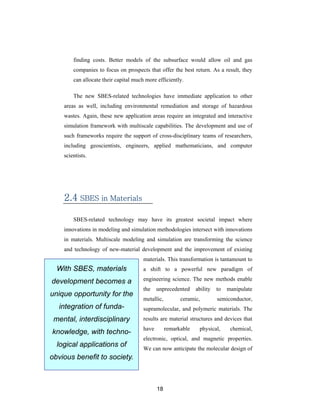










![3.0 CORE ISSUES: Challenges,
Barriers, and Opportunities in
SBES Research
All of the driving applications discussed in the preceding chapter share
common challenges, barriers, and requirements for research breakthroughs. We
elaborate on the major issues in this chapter.
3.1 The Tyranny of Scales: The Challenge of
Multiscale Modeling and Simulation
Researchers in the worldwide race toward miniaturization, nanoscience,
molecular modeling of drugs and biological systems, advanced materials, and
other applications, all of which involve events on atomistic and molecular levels,
have run into a formidable roadblock: the tyranny of scales. Virtually all
simulation methods known at the beginning of the twenty-first century were valid
only for limited ranges of spatial and temporal scales. Those conventional
methods, however, cannot cope with physical phenomena operating across large
ranges of scale—12 orders of magnitude in time scales, such as in the modeling
of protein folding [4, p. 4], or 10 orders of magnitude in spatial scales, such as in
the design of advanced materials. At those ranges, the power of the tyranny of
scales renders useless virtually all conventional methods. Confounding matters
further, the principal physics governing events often changes with scale, so that
the models themselves must change in structure as the ramifications of events
29](https://image.slidesharecdn.com/sbesfinalreport-110314050635-phpapp02/85/Simulation-Based-Engineering-Science-Report-49-320.jpg)

![natural events at multiple scales will require the efforts of interdisciplinary teams
of researchers and thinkers working in concert.
We can see instances already where preliminary and often ad hoc
methodologies have retarded technological progress. The design of nanodevices
is one example. Nanodevices are systems with tiny masses and relatively large
surface areas. The design of such devices is in urgent need of new simulation
tools, because they are at a scale too small to be captured by continuum
mechanics. Another example is any biological application that requires methods
that link diverse time scales. For instance, the sequence of events following a
medical implant is initiated by the interactions between individual water
molecules and the surface of the implant. This first set of interactions occurs on a
timescale of nanoseconds. The resulting water “shell,” in turn, has an influence
on proteins and other types of molecules that arrive later. This second set of
interactions has a timescale from microseconds to milliseconds. Thus, there is a
significant time gap in the behavior that is difficult to model. Similarly, temporal
gaps in the behavior of polymers cause problems for current simulation methods.
Numerous important applications of nanotechnology are being driven by
homeland security. As a result, the need and urgency for developing multiscale
tools has increased significantly. For example, we know that small concentrations
of chemical and biological agents can have lethal effects on large segments of the
human population. The recognition of that threat has prompted development of
new mitigation methods, such as miniaturized intelligent sensors, protective
clothing, and masks. The need for engineered nanostructured materials for
homeland-security applications, as well as for optical and structural applications,
has spurred much interest in the development of multiscale methods that can
accommodate diversity in spatial scales.
Recent work in multiscale modeling has emphasized the synthesis of theories
applicable to different scale ranges, such as quantum, molecular, and continuum
descriptions [5, p. 1504]. Nevertheless, enormously important technological
31](https://image.slidesharecdn.com/sbesfinalreport-110314050635-phpapp02/85/Simulation-Based-Engineering-Science-Report-51-320.jpg)
![problems, such as turbulence modeling, remain unsolved. These problems
involve a very broad range of scales amenable to a single description, such as
continuum theory in the case of turbulence. In fact, turbulent-flow problems in
practical engineering involve such an enormous range of scales that they cannot
be currently solved on the world’s largest and fastest computers. If we assume
that progress continues at the rate of Moore’s Law, the turbulence-flow problems
will not succumb to solutions for many generations to come. The implications of
solving these problems are great; for example, they have to do with our
leadership in designing future generations of commercial and military aircraft.
Before we can lead, however, we must find the path to fundamental
developments in multiscale modeling.
The urgency of the development of multiscale simulation models has been
felt worldwide. Over the past five years, virtually every conference, symposium,
and international congress devoted to computational engineering and science has
listed multiscale modeling as an important theme. Multiscale modeling has often
been the subject of colloquia, study groups, or invited lectures. Three DOE
workshops were recently held on multiscale mathematics [8, 23, 10], and
programs at NSF and NIH are already in place for promoting the beginnings of
new research in this area. In recent years, a large and growing body of literature
in physics, chemistry, biology, and engineering has focused on various methods
to fit together simulation models of two or more scales, and this has led to the
development of various multi-level modeling approaches. To date, however,
progress on multiscale modeling has been agonizingly slow. Only a series of
major breakthroughs will help us establish a general mathematical and
computational framework for handling multiscale events and reveal to us the
commonalities and limitations of existing methods.
32](https://image.slidesharecdn.com/sbesfinalreport-110314050635-phpapp02/85/Simulation-Based-Engineering-Science-Report-52-320.jpg)




![3.3 Dynamic Simulation Systems, Sensors,
Measurements, and Heterogeneous Simulations
One of the most challenging applications of SBES, but one that may yield the
greatest dividends, is the linkage of simulation tools directly to measurement
devices for real-time control of simulations and computer predictions. Some
preliminary investments in the research into this new idea have been made under
NSF’s program in dynamic data-driven applications systems (DDDAS) [7, 9].
The full development of this revolutionary and fundamentally important
discipline will take years of research and technological development.
The concept of DDDAS is envisioned as a new paradigm in computer
simulation, one involving a “symbiotic feedback control system” [7, 9] in which
simulations and experiments (or field data) interact in real time to dramatically
improve the fidelity of the simulation tool, its accuracy, and its reliability.
The document that originally put forth the idea [7], now over five years old,
described the goal of DDDAS as one of developing “application simulations that
can dynamically accept and respond to ‘online’ field data and measurements
and/or control such measurements. This
synergistic and symbiotic feedback control loop
among applications, simulations, and
This synergistic and
measurements is a novel technical direction that symbiotic feedback
can open new domains in the capabilities of control loop among
simulations with a high potential payoff, and
applications, simulations,
create applications with new and enhanced
capabilities. It has the potential to transform the and measurements has
way science and engineering are done, and the potential to transform
induces a major beneficial impact in the way
the way science and
many functions in our society are conducted, such
engineering are done.
37](https://image.slidesharecdn.com/sbesfinalreport-110314050635-phpapp02/85/Simulation-Based-Engineering-Science-Report-57-320.jpg)


![3.4 New Vistas in Simulation Software
Many contemporary engineering communities regard simulation software as
a commodity that vendors provide for well-defined, specific, and independent
domains of application. Occasionally, these long-lived codes for engineering
analysis receive incremental improvements, usually in the form of functional
extensions. This leisurely approach to software development will not support the
next generation of engineering problems—multiscaling with real-time data
interaction and abundant uncertainties in the data. As the PITAC report states
[14], “Today it is altogether too difficult to develop computational science
software and applications. Environments and toolkits are inadequate to meet the
needs of software developers in addressing increasingly complex
interdisciplinary problems. Legacy software remains a persistent problem
because the lifetime of a computational science application is significantly
greater than the three- to five-year life cycle of a computing system. In addition,
since there is no consistency in software engineering best practices, many of the
new applications are not robust and cannot easily be ported to new hardware.”
For those reasons, entirely new approaches are
needed for the development of the software that will
Entirely new
encapsulate the models and methods used in SBES.
approaches are Researchers must identify the methodologies that support
needed for the the interoperability of individual components of
development of the simulation software. Then they must develop those
methodologies and integrate them into the next
software that will
generation of engineering software. This search for new
encapsulate the methods and tools to support simulation software
models and development is fraught with difficulties. Not only do the
new simulation components require complex algorithms,
methods used in
they must also function efficiently on an evolving range
SBES.
40](https://image.slidesharecdn.com/sbesfinalreport-110314050635-phpapp02/85/Simulation-Based-Engineering-Science-Report-60-320.jpg)
![of architectures designed for large-scale parallel computations.
Tomorrow’s SBES software requires extraordinary degrees of robustness,
efficiency, and flexibility. The new software must not only execute simulation
algorithms, but must also dynamically manage data throughput and model
adaptivity and control. It must steer observational and measurement systems to
optimize data collection and use. It must navigate efficiently across models of
multiple scales and accommodate multiple physical theories, and it must have
scalable methods that interact seamlessly with data-gathering devices.
Much of our contemporary software development tools—libraries (for
instance, linear equation solvers), language interoperability tools, component
coupling and data transfer tools, and simulation development frameworks—do
not meet the demands of SBES. To define the real requirements for the
implementation of SBES technologies, we require a new paradigm of software
development. Such a fundamental change calls for a great deal of “out-of-the-
box” thinking about the way we approach software
development and practice engineering. The change Not only will tomorrow’s
will even affect the way scientific computing is
software developers
taught and perceived in our universities. Not only
will tomorrow’s software developers have to cope have to cope with more
with more complex systems and heterogeneous complex algorithms,
hardware systems, but they will also have to
but they will also have
understand the important details of the applications.
to understand the
Whereas the future of SBES software is largely
important details of the
uncharted, some path-finding work is under way. A
Federal government group, for instance, has taken a applications.
similarly aggressive software philosophy and
developed software with which to bootstrap. This effort is called the Scientific
Discovery Through Advanced Computing (SciDAC) initiative [26] (see also
Chapter 2 of [18]). Organized in 2001, SciDAC is a highly interdisciplinary
41](https://image.slidesharecdn.com/sbesfinalreport-110314050635-phpapp02/85/Simulation-Based-Engineering-Science-Report-61-320.jpg)



![have a dramatic impact on scientific, biomedical, and engineering research;
defense and national security; and industrial innovations.
The reason visualization is such a powerful tool is that it is fundamental to
our ability to interpret models of complex phenomena, such as multilevel models
of human physiology from DNA to whole organs, multi-century climate shifts, or
multidimensional simulations of airflow past a
jet wing. Visualization reduces and refines data Visualization is
streams rapidly and economically, thus enabling fundamental to our ability
us to winnow huge volumes of data – an ability
to interpret models of
important in applications such as the
surveillance of public health at a regional or complex phenomena,
national level in order to track the spread of such as multilevel models
infectious diseases. Visualization for solving
of human physiology from
problems in applications like hurricane
dynamics and homeland security are generating
DNA to whole organs,
new knowledge that crosses traditional multi-century climate
disciplinary boundaries. Finally, the use of shifts, or multidimensional
visualization is rapidly transforming business
simulations of airflow past
and engineering practices for the better [15],
thereby increasing the competitive edge of our a jet wing.
industry.
Visualization allows people to comprehend visual representations of data
much more rapidly than they can digest the raw numbers or text. The designers
of computer visualization tools exploit the high-bandwidth channel of human
visual perception. Software systems may provide either static or interactive
visual representations of data, depending on user needs and on whether the final
goal is the explanation or the exploration of the data.
Visual representation of information has a rich historical tradition, primarily
in manually created depictions such as anatomical drawings, spread sheets or
45](https://image.slidesharecdn.com/sbesfinalreport-110314050635-phpapp02/85/Simulation-Based-Engineering-Science-Report-65-320.jpg)
![basic graphics. Now, however, computer graphics has the scalability to handle
datasets much larger than any that could be manually depicted. In addition,
computer graphics offers new possibilities in animation and interactivity.
Visualization is useful for detecting patterns, assessing situations, and prioritizing
tasks. Computation alone does not lead to understanding. The end user also needs
a comprehensible interface with the computational output. Visualization provides
that interface, and in so doing becomes the key to the interpretation of the data.
Engineers need assistance in making complex decisions and analyses,
especially with tasks involving large amounts of data. Often, engineers have to
deal with over-specified situations, and visualization of the situation helps them
filter out the irrelevant data. Engineers can use visual analysis systems to explore
“what if” scenarios and to examine data under multiple perspectives and
assumptions. They can identify connections between any number of attributes,
and they can assess the reliability of any conclusions [15].
Visualization research must continually respond to
We need to create and address the needs of the scientific community. For
an SBES example, the ability to visualize measures of error and
uncertainty will be fundamental to a better
visualization
understanding of three-dimensional simulation data.
framework for This understanding will allow the validation of new
uncertainty and to theoretical models, improve the interpretation of data,
investigate and and facilitate decision-making. With few exceptions,
however, visualization research has ignored the need
explore new visual
for visual representation of errors and uncertainty for
representations for three-dimensional visualizations [16]. We need to
characterizing error create an SBES visualization framework for
uncertainty and to investigate new visual
representations for characterizing error and uncertainty.
Within DDDAS and SBES applications, visualization of time-dependent data
46](https://image.slidesharecdn.com/sbesfinalreport-110314050635-phpapp02/85/Simulation-Based-Engineering-Science-Report-66-320.jpg)

![New approaches to algorithmic visualization will be needed that focus on the
needs of SBES. One approach is interrogative visualization, which is another
way of saying that quantitative querying through analysis must be supported
hand-in-hand with fast rendering of domains and computed function fields. A
second approach is interpretive visualization. Interpretive visualization focuses
on informatics and techniques to interpret imaging data, as well as various
quantitative-analysis data. For example, going from imaging data to the
construction of a domain model is an arduous task. In particular, to capture
spatial domain realism at each of the desired scales of simulation is daunting, and
may in fact be impossible.
A third approach is repetitive visualization. Humans have several
biorhythms. We have the daily circadian rhythm of mental efficiency, and we
alternate between periods of work and rest. We should accommodate biorhythms
in our methodologies for quantitative or interpretive visualization. In other
words, we should develop a mathematical framework for visualizations that
allows our perceptions of information to change with repeated visualizations of
that information. Additionally, if we are simulating the same function using
models at varying scales, we would have a natural opportunity to revisit our
earlier visualizations and make comparisons at multiple scales [2].
Because of the complexity and the massive amounts of data from
simulations, researchers will turn to semi-automated techniques from the
multidisciplinary field of scientific data mining to extract useful information
from the data. To meet this purpose, data-mining techniques exploit ideas from
image and video processing, statistics, pattern recognition, mathematical
optimization, and other fields. Scientific data-mining techniques can be used to
quantitatively compare simulations to each other and to experiments, to extract
summary statistics from high-fidelity simulations for use in building models, and
to analyze experimental data.
Whereas data-mining techniques can be effective in the extraction of
48](https://image.slidesharecdn.com/sbesfinalreport-110314050635-phpapp02/85/Simulation-Based-Engineering-Science-Report-68-320.jpg)
![information from simulation data, several open challenges remain. Those
challenges include the extraction of features of interest from adaptive mesh
refinements and unstructured grids, the processing and interpretation of
experimental images that are often of low quality, the definition of metrics used
in comparisons of simulations and experiments, and the analysis of distributed
data sets resulting from simulations on parallel systems [17].
Finding
Visualization and data management are key technologies for enabling future
contributions in SBES. In addition, they hold great promise for scientific
discovery, security, economic competitiveness, and other areas of national
concern. Computer visualization will be integral to our ability to interpret and
utilize the large data sets generated in SBES applications.
3.6 Next-Generation Algorithms and
Computational Performance
Algorithms, the recipes for turning mathematical into computational
processes, provides the bridge between the models describing physical and
engineered systems, on the one hand, and the computational devices that generate
the digital representations of simulations, on the other. Too often, only the speed
of a computational device is cited as the figure of merit for simulation
performance, and the impact of algorithms on reducing the time complexity
(number of operations) and space complexity (size of memory) is unappreciated.
For more than three decades, progress in microprocessor capabilities has been
described by Moore’s Law, the observation that the number of transistors per unit
49](https://image.slidesharecdn.com/sbesfinalreport-110314050635-phpapp02/85/Simulation-Based-Engineering-Science-Report-69-320.jpg)
![area on a processor doubles every 18 months, with corresponding increases in
practical performance for a fixed algorithm. Faster and more cost-effective
hardware is a strong driver for simulation-based engineering. However,
algorithmic improvements have been far more important.
In tomorrow’s SBES environment, the computing performance of individual
microprocessors will be just one of many important factors. New metrics will be
needed to judge the effectiveness of systems based on SBES principles. More
fundamental metrics include: time to solution in a multiprocessor environment,
the wall-clock time that elapses from the initiation of the simulation process to
the predicted outcome, and a measure of the confidence level for the predicted
result. If the time to solution is short, but the quality of and confidence in the
solution are low, the prediction may be of little value.
Improved algorithms have resulted in significant performance gains as
measured by time to solution. Recent studies have noted remarkable progress in
this area [3, 13, 18]. Figure 5 shows an example of that progress. The figure
depicts improvements in performance for large-scale simulations of turbulent
gas-phase combustion [19, p. 79]. As the example shows, advances in simulation
algorithms have tripled the effective performance over that due to advances in
processor speed alone over a period of a couple of decades. Similar results have
been documented in many other domains, such as magnetohydrodynamics and
radiation transport, and should inspire efforts to obtain and document super-
Moore’s Law gains in all areas of SBES
Among the most challenging problems for new algorithms are optimization
and inverse problems. Simulation-based decision-making gives rise to complex
optimization problems, which are governed by large-scale simulations. These
optimization problems appear in engineering design (in which the decision
variables represent the configuration and constitution of the system) and in
manufacturing and operations (in which the decision variables represent control
parameters). Moreover, decision-making informed by predictive simulation
50](https://image.slidesharecdn.com/sbesfinalreport-110314050635-phpapp02/85/Simulation-Based-Engineering-Science-Report-70-320.jpg)
![requires estimations of uncertain parameters that characterize the simulation. The
response to the resulting inverse problems is to seek estimates for those
parameters that minimize discrepancies with observations.
Figure 5. Increases in time to solution due to new algorithms, given in
effective gigaflops over a period of years during which Moore’s Law, the
bottom line on this log-linear plot, remains valid (from [19, p. 79]).
Unfortunately, simulation-based optimization—whether in the form of
optimal design, optimal control, or inverse problems—is notoriously more
challenging than the corresponding simulation. First, the optimization problem is
typically ill-posed, even though the simulation problems themselves are usually
well-defined. Second, optimization usually results in a four-dimensional space-
time boundary-value problem, despite the evolutionary nature of the forward
problem. Third, the optimization problem is often formulated in probabilistic
terms. Fourth, the simulation is merely a subproblem associated with
optimization, which can be orders of magnitude more computationally
challenging. Indeed, when the simulation problem requires terascale resources,
51](https://image.slidesharecdn.com/sbesfinalreport-110314050635-phpapp02/85/Simulation-Based-Engineering-Science-Report-71-320.jpg)

![4.0 THE CRISIS OF THE KNOWLEDGE
EXPLOSION: SBES Education for
Tomorrow’s Engineers and
Scientists
In Volume Two of the SCaLeS Report [19], one finds mention of the “crisis
of the knowledge explosion.” This expression refers to the dramatic expansion
of the knowledge base required to advance modern simulation. The expansion
ignores the traditional boundaries between academic disciplines, which have long
been compartmentalized in the rigid organizational structures of today’s
universities. The old silo structure of educational institutions has become an
antiquated liability. It discourages innovation, limits the critically important
exchange of knowledge between core disciplines, and discourages the
interdisciplinary research, study, and interaction critical to advances in SBES.
The PITAC report [4] lists the following as one its principal
recommendations [4, p. 9]: “Universities must significantly change their
organizational structures to promote and reward collaborative research that
invigorates and advances multidisciplinary science. Universities must implement
new multidisciplinary programs and organizations that provide rigorous,
multifaceted education for the growing ranks of computational scientists the
nation will need to remain at the forefront of scientific discovery.” The report
goes on to ask: Will research and educational study in the twenty-first century be
“medieval or modern?”
The Panel strongly supports the viewpoint of the PITAC Report. If
simulation is to become a discipline, an engineering tool, and a life-long learning
53](https://image.slidesharecdn.com/sbesfinalreport-110314050635-phpapp02/85/Simulation-Based-Engineering-Science-Report-73-320.jpg)
